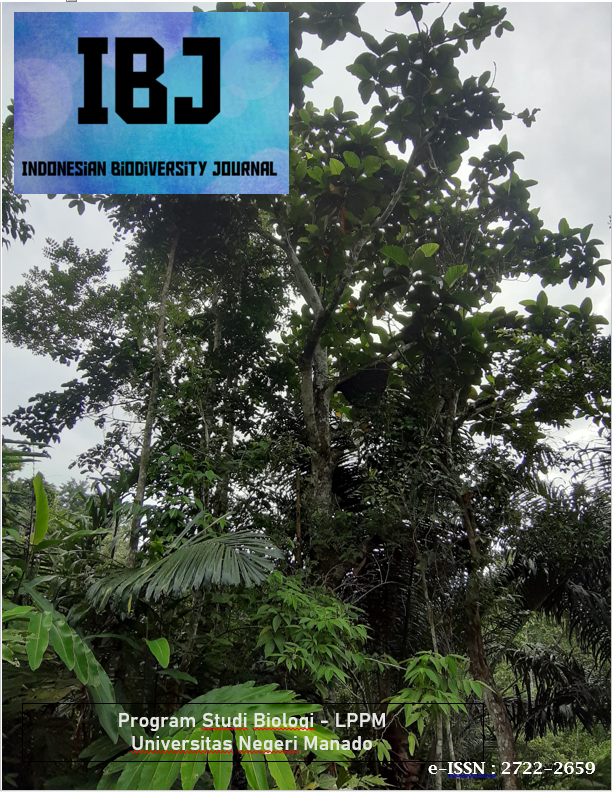Antibacterial Activity Of Sago Caterpillar Oil (Rhynchoporus bilineatus L.) From Minahasa Against Salmonella typhi and Staphylococcus aureus
DOI:
https://doi.org/10.53682/ibj.v5i3.10760Keywords:
sago caterpillar oil, antibacterial, bioactive, Salmonella thypii, Staphylococcus aureusAbstract
Sago caterpillars are ethnomedically used as food and medicine by the people of several tribes in Indonesia. Sago caterpillar oil contains active compounds, especially fatty acids that have antibacterial potential. Research has been carried out which aims to obtain the bioactive content of sago worm oil and the antibacterial activity of Salmonella typhi and Staphylococcus aureus bacteria. Sago caterpillars are obtained from the Minahasa region. Four to six instar sago caterpillars are used for oil isolation. Analysis of the content of sago worm oil using the Gas Chromatography Mass Spectrophotometry method. Meanwhile, the antibacterial test used the agar diffusion method using pure cultures of Salmonella thypii and Staphylococcus aureus. The results showed that the average sago caterpillar oil was 0.26 to 0.28 ml per head. The results of the antibacterial test showed the highest inhibition of S. aureus at a concentration of 1000 mg/L, namely 8.04 mm, while the inhibition of growth of S. thypii was highest at a concentration of 1000 mg/L, namely 7.69 mm. Sago caterpillar oil has antibacterial potential.
References
Alghamdi, B. A., Al-Johani, I., Al-Shamrani, J. M., Alshamrani, H. M., Al-Otaibi, B.G., Almazmomi, K., Yusof, N.Y. (2023). Antimicrobial resistance in methicillin-resistant Staphylococcus aureus. Saudi journal of biological sciences. 30(4):103604. https://doi.org/10.1016/j.sjbs.2023.103604
Bilyk, B. L, Panchal, V. V., Tinajero-Trejo, M., Hobbs, J. K., Foster, S. J. (2022). An interplay of multiple positive and negative factors governs methicillin resistance in Staphylococcus aureus. Microbiology and Molecular Biology Reviews. 86(2):e00159-21. https://doi.org/10.1128/mmbr.00159-21
Bradshaw, J.P. (2003). Cationic Antimicrobial Peptides. BioDrugs 17, 233–240 https://doi.org/10.2165/00063030-200317040-00002
Chinarak, K., Panpipat, W., Panya, A., Phonsatta, N., Cheong, L. Z., Chaijan, M. (2022). Improved long-chain omega-3 polyunsaturated fatty acids in sago palm weevil (Rhynchophorus ferrugineus) larvae by dietary fish oil supplementation. Food Chemistry. 393:133354. https://doi.org/10.1016/j.foodchem.2022.133354
Chinarak, K., Panpipat, W., Summpunn, P., Panya, A., Phonsatta, N., Cheong, L, Z., Chaijan, M. (2021). Insights into the effects of dietary supplements on the nutritional composition and growth performance of sago palm weevil (Rhynchophorus ferrugineus) larvae. Food Chemistry 363:130279. https://doi.org/10.1016/j.foodchem.
Chinarak, K., Chaijan, M., Panpipat, W. (2020), Farm-raised sago palm weevil (Rhynchophorus ferrugineus) larvae: Potential and challenges for promising source of nutrients. Journal of Food Composition and Analysis 92:103542. https://doi.org/10.1016/j.jfca.2020.103542
Desbois., A. (2012). Potential applications of antimicrobial fatty acids in medicine, agriculture and other industries. Recent patents on anti-infective drug discovery, 7(2), 111-122. https://doi.org/10.2174/157489112801619728
Efenberger-Szmechtyk, M., Nowak, A., Czyzowska, A. (2021). Plant extracts rich in polyphenols: Antibacterial agents and natural preservatives for meat and meat products. Critical reviews in food science and nutrition. 61(1):149-78. https://doi.org/10.1080/10408398.2020.1722060
Hillyer, J.F. (2016). Insect immunology and hematopoiesis. Dev Comp Immunol 58:102–118. https://doi.org/10.1016/j.dci.2015.12.006
Jia, K., Fang, T., Wang, X., Liu, Y., Sun, W., Wang, Y., Ding, T., Wang, J., Li, C., Xu, D., Qiu, J. (2020). Antibiotic resistance patterns of Staphylococcus aureus isolate from retail foods in mainland China: A meta-analysis. Foodborne Pathogens and Disease. 17(5):296-307. https://doi.org/10.1089/fpd.2019.2686
Liu, A., Garrett, S., Hong, W., Zhang, J. (2024). Staphylococcus aureus Infections and Human Intestinal Microbiota. Pathogens. 13(4):276. https://doi.org/10.3390/pathogens13040276
Manniello, M.D., Moretta, A., Salvia, R. et al. (2021). Insect antimicrobial peptides: potential weapons to counteract the antibiotic resistance. Cell. Mol. Life Sci. 78, 4259–4282 https://doi.org/10.1007/s00018-021-03784-z
Mlynarczyk-Bonikowska, B., Kowalewski, C., Krolak-Ulinska, A., Marusza, W. (2022). Molecular mechanisms of drug resistance in Staphylococcus aureus. International journal of molecular sciences. 23(15):8088. https://doi.org/10.3390/ijms23158088
Mssillou, I., Agour, A., Allali, A., Saghrouchni, H., Bourhia, M., El Moussaoui, A., Salamatullah, A.M., Alzahrani, A,. Aboul-Soud, M. A., Giesy, J. P., Lyoussi, B. (2022). Antioxidant, Antimicrobial, and Insecticidal Properties of a Chemically Characterized Essential Oil from the Leaves of Dittrichia viscosa L. Molecules. 27(7):2282. https://doi.org/10.3390/molecules27072282
Korua, S., Pelealu, J., Tulung, M., Mandey, L., Semuel, M.Y. (2016), Molecular Barcoding and Phylogeny Reconstruction of Rhynchoporus sp in Minahasa North Sulawesi Based Partial Cytochrome Oxidase Sub Unit 1 Gene (CO1). DNA. 6(16).
Köhler, R., Irias-Mata, A., Ramandey, E. et al. (2020). Nutrient composition of the Indonesian sago grub (Rhynchophorus bilineatus). Int J Trop Insect Sci 40, 677–686 https://doi.org/10.1007/s42690-020-00120-z
Ohta, S., Shiomi, Y., Kawashima, A. et al. (1995). Antibiotic effect of linolenic acid fromChlorococcum strain HS-101 andDunaliella primolecta on methicillin-resistantStaphylococcus aureus . J Appl Phycol 7, 121–127 https://doi.org/10.1007/BF00693057
Rombot, D. V., Semuel, M. Y., & Kanan, M. (2023). Bacterial Species Associate on the Body Surface of Musca domestica L from Various Habitats based on 16S rRNA Sequencing. Journal of Pure & Applied Microbiology, 17(3). 10.22207/JPAM.17.3.10
Pietrocola, G., Campoccia, D., Motta, C., Montanaro, L., Arciola, C. R., Speziale, P. (2022). Colonization and infection of indwelling medical devices by Staphylococcus aureus with an emphasis on orthopedic implants. International journal of molecular sciences. 23(11):5958. https://doi.org/10.3390/ijms23115958
Promwee, A., Chinarak, K., Panpipat, W., Panya, A., Phonsatta, N., Harcet, M., Chaijan, M. (2023), Balancing the Growth Performance and Nutritional Value of Edible Farm-Raised Sago Palm Weevil (Rhynchophorus ferregineus) Larvae by Feeding Various Plant Supplemented-Sago Palm Trunk Diets. Foods. 12(18):3474. https://doi.org/10.3390/foods12183474
Savchenko, R.G., Veskina, N.A., Odinokov, V.N. et al. (2022). Ecdysteroids: isolation, chemical transformations, and biological activity. Phytochem Rev 21, 1445–1486. https://doi.org/10.1007/s11101-021-09792-y
Sychrová, A., Koláriková, I., ŽemliÄka, M. et al. (2020). Natural compounds with dual antimicrobial and anti-inflammatory effects. Phytochem Rev 19, 1471–1502. https://doi.org/10.1007/s11101-020-09694-5
Trees, T. (2022), Sago Caterpillar: Alternative Local Food Sources of Nutrition Post Pandemic Family. Asian Journal of Healthy and Science.1(2):57-62.
Vallet-Gely, I., Lemaitre, B. & Boccard, F. Bacterial strategies to overcome insect defences. Nat Rev Microbiol 6, 302–313 (2008). https://doi.org/10.1038/nrmicro1870
Yap, J. W., Lee, Y. Y., Tang, T. K., Chong, L. C., Kuan, C. H., Lai, O. M., Phuah, E. T. (2023). Fatty acid profile, minor bioactive constituents and physicochemical properties of insect-based oils: a comprehensive review. Critical Reviews in Food Science and Nutrition. 63(21):5231-46. https://doi.org/10.1080/10408398.2021.2015681
Yamazaki, Y., Ito, T., Tamai, M. et al. (2024). The role of Staphylococcus aureus quorum sensing in cutaneous and systemic infections. Inflamm Regener 44, 9. https://doi.org/10.1186/s41232-024-00323-8










